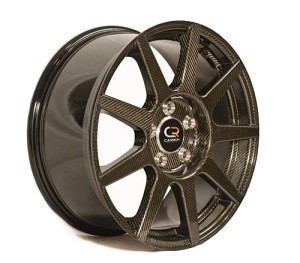Jun 22 2012
Ground breaking technology that truly moves the global automotive industry doesn't come along often. In such a massive and highly sophisticated sector, serious innovations are almost always the work of the major players in Europe or the USA. Anomalies and exceptions to this are rare, particularly in the areas of light-weighting and true performance enhancement.
 Carbon Revolution CR-9 Front wheel. (PRNewsFoto/Carbon Revolution)
Carbon Revolution CR-9 Front wheel. (PRNewsFoto/Carbon Revolution)
Over the past 7 years just such an anomaly has been created by a group that has remained ferociously independent of any global OEM. An Australian based venture has succeeded in solving one of the last remaining holy grails of the industry - A full one-piece carbon fiber composite wheel. This has been achieved through a remarkable series of partnerships and the assembly of an unrivalled group of technical and industrial talent.
The company's name is Carbon Revolution and the Product is the CR9.
It started as an independently run R&D program in close collaboration with a leading research institution. This rapidly evolved into a highly focused and effective group of leading engineers, scientists and industrialists within a tightly managed innovation cell. This group has met both the product design challenge as well as the manufacturing challenge head-on.
The results are staggering. The wheels are 40% -50% lighter than premium OEM equivalents made from Aluminum, yet they are exceeding OEM standards in laboratories and on testing tracks around the world. Breathtaking improvements in acceleration, braking, ride and handling have handed the driver a significantly improved vehicle with an extra chunk of horsepower, and a huge fuel efficiency gain.
The manufacturing process is highly efficient and controllable. It has merged the rigor of aerospace processes with the efficiency and control of high volume automotive production. The full scale production lines will be fully automated - human interaction will be limited to the supervision of sophisticated machinery and robotic equipment. Achieving global OEM standards for component supply (TS16949) is just part of the overall world class approach to quality and process control. This approach has attracted strong support and funding from the Australian Government under its $5.4 billion New Car Plan.
The wheels are constructed from continuous fiber, so the phenomenal strength and stiffness characteristics of carbon fiber are optimized. Computational modeling techniques including full vehicle dynamic modeling and finite element analysis (FEA) reflect the primary research backgrounds and passion of the founders. So advanced is the approach that Carbon Revolution is now working closely with specialist FEA partners to develop new and better approaches to accurately modeling the specific properties of carbon fibers. This is to account for the vastly more complex behavior of fiber laminates versus cast or forged metals. The group is now achieving computational simulations that are so closely correlated to reality that product development timeframes are being dramatically shortened. It's far from being a typical 'build and break' development process.
The team has designed and patented a highly sophisticated bolted joint system which elegantly solves the challenges of attaching composites to metals under dynamic loading conditions. Advanced aerospace alloys are combined with the carbon fiber to ensure that the 'bolted joint' element of the technology is as highly engineered as its composite structure.
It's easy to see why such a rigorous and sophisticated approach has been possible when you consider the origins of this team. Amongst the founders and subsequent hires are ex-OEM senior engineers from chassis development and drive train roles, senior manufacturing executives from component suppliers including Bosch, converts from Boeing's renowned Phantom Works innovation cell, industrial composites manufacturing specialists and numerous PhD's with world leading materials and structures knowledge. In addition to this, Carbon Revolution has numerous formal partnerships for technology development and product testing around the world. This includes Deakin University and RMIT in Australia, respectively the pre-eminent materials sciences and aerospace technology institutes in the region.
Carbon Revolution conducted much of the early laboratory testing in Germany using techniques and test rigs that are favored by OEMs over the common industry tests. This approach has ensured that the most rigorous standards imposed by European OEMs have been tested for in the best German laboratories. They could not have set the bar higher than this.
Outside the lab, the team has favored a multi-region approach to accumulating miles in the field. The Nurburgring is favored for limit handling and durability trials, Hockenheim for closed track, whilst Route 66 in the USA is the choice for extended rough road durability miles. A host of other locations have also been used in the quest for the most complete and comprehensive validation program.
Carbon Revolution has teamed up with automotive industry veteran and luminary Bill Koenig of Manhattan Beach, California who has taken on the role of educating the market further about this technology. "Bill has the right level of passion and a true understanding of what this technology can really deliver to a driver. He is the ideal match for our team as we move into the market with our first product" says Brett Gass, one of the Founders and the Engineering Director at Carbon Revolution. Gass is now based in Germany where the company has established an office to service the automotive industry across Europe. As an internationally recognized expert in ride and handling, and with a long history inside OEMs, he manages all technical aspects of that relationship to ensure that customers 'get it'.
Carbon Revolution is in the process of commissioning its first commercial production line. Much of the capacity of this line will be used in further development work across the automotive OEM, Aerospace and Industrial sectors, but a small number of wheels will be available to the market globally over the coming months. The word is out and you can expect to hear more about product launches in 2012.